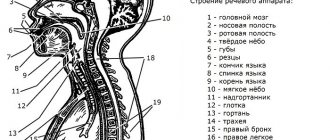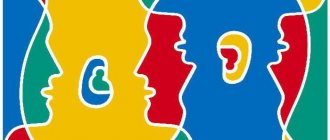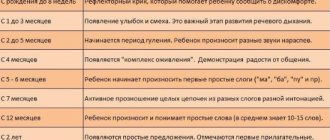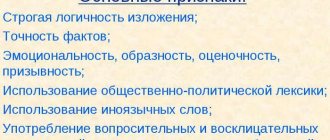Types of speech in Russian
Each text has a theme or main idea, what the author wanted to say. He can do this—express his position—in a variety of forms. Depending on the key in which he constructs his thought, types of speech are formed.
Types of speech are functional varieties of texts.
In total we can distinguish three types of speech:
- narration;
- description;
- reasoning.
Narration is the most common type of speech, both oral and written. Its purpose is to tell a story. In a story, all events must be logically connected; it must have a clear beginning and end. The listener or reader must have a good understanding of the main idea of the story, who it happens to, where and when. The main feature of this type of speech is the large number of verbs.
Description, as the name implies, is needed in order to describe an object or situation. Its main goal is to convey to the reader or listener the image that the author sees. Descriptions are usually full of adjectives and adverbs.
Reasoning is the type of speech that occurs least often. During reasoning, a person explains the reasons, expresses his thoughts and views about a problem.
It is very difficult to confuse types of speech with each other. They all have a specific, clearly defined function. If a person cannot understand what type of speech is in front of him, he should simply answer the question - for what purpose was the text written? If it's to tell a story, then it's storytelling. If the purpose is to show some object or phenomenon, then a description. If in order to convey a fresh idea to the reader, then reasoning.
Difference between speech types and speech styles
Speech types are very often confused with speech styles. In fact, these are two completely different phenomena.
Speech styles are a set of speech elements characteristic of a particular situation.
There are five of them in total:
- colloquial;
- art;
- journalistic;
- scientific;
- official business.
So, for example, in a conversational style you can use jargon and vernacular, while in other styles this is unacceptable. And the scientific style is characterized by general dryness, logic and accuracy.
Types of speech are a completely different matter. This is a way of presenting this or that material depending on its purpose.
Styles and types of speech are not directly correlated. So, for example, in a text written in an artistic style, there can be any sentences: narrative, descriptive, as well as reasoning. The same can be said about journalistic and conversational styles. In scientific and official business, descriptions still prevail.
What is text style
Text style is a system of means of expressive language that is usually used in a certain communicative environment.
Its application depends on:
- the situation in which the text is used;
- audience of readers;
- storytelling purposes.
One and the same phenomenon can be written in completely different ways. Here is an example of describing rain in different styles:
- The Ministry of Emergency Situations warns that heavy rains with hail and wind gusts of up to 20 m/s are expected in the next 24 hours.
- The first autumn rain was pouring outside the window. The puddles reflected yellowing, and in some places still green, foliage. The wind exposed the dark branches of the trees and tore up the withered leaves. The sidewalks looked like raging rivers overflowing their banks.
In the first case, an official business style is used. It is intended for a wide audience. Its goal is to convey information dryly and concisely without using any means of expression, to warn the reader about bad weather.
The second example uses an artistic storytelling style. Means of expression are used: epithets, metaphor. Its goal is to describe the beauty of nature, to create a certain visual image in the reader. The audience is readers of fiction.
Description. Structure and Features
As was said earlier and as is clear from the very name of this type of speech, a description was created in order to describe something, to give the most complete characteristics. It doesn’t matter what exactly: an object, a phenomenon or an event. Typically, this genre is used in fiction to immerse readers as deeply as possible into the world that the author creates.
Authors of commercial texts do not shy away from descriptions either. The brighter, more colorful and more profitable a product is described, the greater the likelihood of demand for it.
Descriptions can also be found in scientific literature. But if in works of art they will be more vivid and imaginative, then in textbooks and monographs they will be more strict, usually in the form of characteristics. The description can be presented in completely different forms.
You can describe different objects: both specific objects and a picture or atmosphere in general. Descriptions of people's appearance and verbal portraits are very common. The authors also periodically evaluate the object being described.
Types of description include:
- description of a person’s appearance (or portrait);
- description of the human condition;
- description of a person's character;
- description of the environment (most often nature);
- description of the area (city, village, locality);
- description of the item.
This type of speech is rich in adjectives, adverbs and various means of artistic expression: epithets, metaphors, hyperboles or litotes. Also in descriptions there are often rows of homogeneous members of a sentence. The verbs in the descriptions are minimal, as are any actions in principle. If they exist, they are mainly in the present tense and in an imperfect form. Sometimes they are introduced to give the reader a more complete picture, but they try not to overuse it.
Examples of text with description
To understand this type of speech even better, it is worth considering specific examples.
Portrait:
She was short, but at the same time very slender, feminine and charming. Her hair was light brown, her eyes were blue, and her lips were slightly swollen. Overall, Anna looked very pretty.
Description of nature:
Rowan is elegant from spring to autumn. Every day the berries on it become more orange and brighter. Until, finally, rowan bonfires flare up on the forest edge. They will burn for a long time, illuminating the forest with their cold flame, until noisy and nimble bands of thrushes swoop down on them for a merry feast.
The psychology of speaking in front of people
In order to attract people's attention, psychologists advise and recommend:
- Pay enough attention to your appearance (dress comfortably and respectably).
- Take a short pause before starting and look around the audience, making eye contact.
- Start your performance at a slow pace. For public speaking, it is recommended to lower the timbre of your voice by 2 tones (this will help protect your vocal cords; a low voice is perceived by people better than a high one) and develop the skill of using various voice techniques.
- Repeat the most important thoughts 3 times.
- Do not exceed the speaking limits, even if the audience’s attention has not weakened.
Choose the most convenient lesson format for yourself. We conduct training exercises during lessons in two formats: “Online” and “Offline” in the center of Moscow.
Find out more about classes
Sign up for a trial lesson
Narration. Design features
Narration is a type of speech that can be used to talk about certain events. The story can come from any person: both from the first and from the third (maybe from the second, but usually this is done for the sake of a literary experiment).
The narrative should be conducted logically and consistently. Any story must have all three basic stages: beginning, climax and denouement. The reader must understand the essence of the story, what the author wanted to tell him.
The narrative usually contains a large number of verbs that contribute to the development of the action. In general, this type of speech is very dynamic, and this is its main difference from the other two.
The presented type of speech can be divided into two subtypes: visual narration, which is characterized by changing images, whose purpose is to “show” the event, and informative. In this case, the text not only talks about the event, but also explains it and includes interesting facts.
Examples of narrative text
Narrative texts are found everywhere. Most of any books consist of them. Here is one example of narrative text:
I began to stroke the cat and thought how good my life was! The house is warm, cozy, smells of baking, the cat is purring. I could sit like this forever!
Reasoning
Reasoning texts are quite complex in their design. First of all, you should understand why you need to write them in the first place.
The main task of such texts is to convey to the reader some idea, the author’s views on a particular problem. Therefore, he must initially formulate a thesis - the main idea of his text, what will be discussed further, then argue it in detail, citing evidence. At the end, the author must draw conclusions and consolidate everything that was said earlier.
Reasoning texts can be divided into three basic categories:
- Proof.
- Explanations.
- Reflections.
However, the main task of reasoning is to convince the reader of something, to show him a different point of view. Reasoning is characterized by enumeration, repetition and clarification.
Examples of text with reasoning
As an example of a text-reasoning, one can cite the philosophical notes of Lev Nikolaevich Tolstoy.
The totality of causes of phenomena is inaccessible to the human mind. But the need to find reasons is embedded in the human soul. And the human mind, without delving into the innumerability and complexity of the conditions of phenomena, of which each separately can be represented as a cause, grabs the first, most understandable convergence and says: this is the cause. In historical events (where the object of observation is the actions of people), the most primitive convergence seems to be the will of the gods, then the will of those people who stand in the most prominent historical place - historical heroes.
Examples of texts in different styles
To better understand what the text of each style looks like, let’s give some visual examples.
Scientific
Here is a short text from a physics textbook:
Example of scientific style
Here we see special vocabulary:
- "electrical circuit";
- "voltage source";
- “current consumer”;
- "resistor";
- "conductor";
- "voltage";
- "load".
The sentences are complex. There is an introductory construction “by the way.”
Official business
An example of an official business style - instructions for filling out a car purchase and sale agreement:
Example of formal business style
The vocabulary of this text is dry, without epithets and bright emotional coloring. The audience is narrow - the participants in the transaction or the person who will fill out the document. The agreement is also drawn up in an official business style.
Art
The description of the oak tree in Leo Tolstoy's famous novel War and Peace is a striking example of artistic, or literary, style:
Example of artistic style
The text contains many epithets and adjectives, comparison, metaphor, allegory. The oak is compared to an old man, and the branches are compared to gnarled fingers.
Journalistic
An example of journalism - a description of a completed project on a news portal:
An example of journalistic style
The text is emotional, evaluative, inviting. The author's point of view is visible. Addressed to a wide audience of readers. Raises the topical topic of waste recycling. All these are signs of a journalistic style.
Colloquial
As an example of colloquial speech formatted into text, we give a description of the well-known keyboard simulator Stamina. The author made the instructions in the form of a blog, communicates with readers in simple colloquial language with humor, slang and a bright emotional coloring of speech:
Conversational style example
Test. How do types of speech differ from each other?
- What part of speech is most often found in descriptions?
- a) adjective;
- b) adverbs;
- c) verbs.
- What are the characteristics of reasoning?
- a) dynamics and abundance of actions;
- b) the presence of numerous characteristics;
- c) statement of the thesis and its detailed analysis, expression of the author’s thoughts on a particular topic.
- What part of speech is most often found in narrative texts?
- a) noun;
- b) adjective;
- c) verbs.
Oral or written
For the most part, public speaking is oral speech. It has many features of oral speech:
- listener-oriented;
- emotionality, spontaneity;
- the use of nonverbal means of communication (that is, non-verbal: facial expressions, gestures, intonation).
But at the same time, public speech also has a number of features of written speech:
- it is not always spontaneous - on the contrary, in most cases public speech is prepared in advance;
- it does not contain colloquial expressions and is not based on a colloquial style - on the contrary, public speech is characterized by the use of book lexical and syntactic means and a full palette of stylistic devices.







